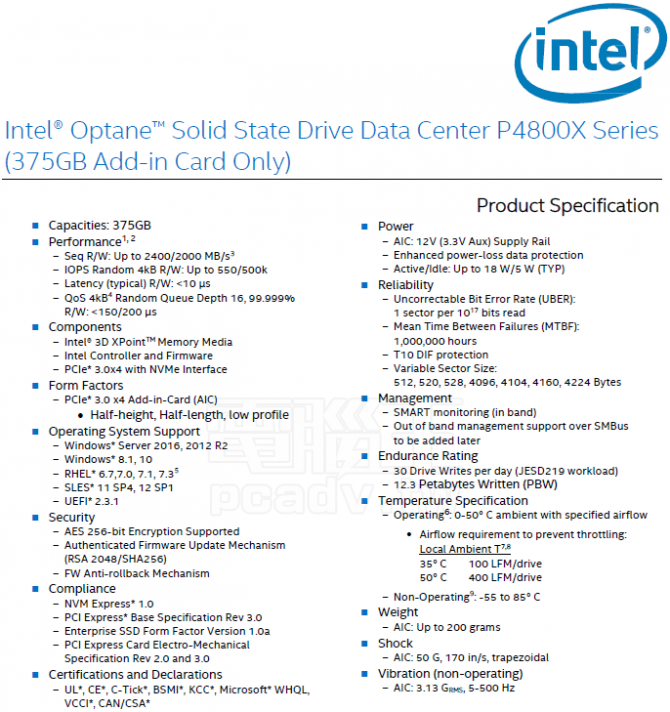The Intel website briefly listed a document with details on the company's first Optane 3D Xpoint SSD. In contrary to most currently known Optane products, that are low capacity caching drives, this Optane drive is a full fledged SSD with a capacity of 375 GB and up to 500,000 IOPS.
The specs are posted by a Taiwanese website which took them from a document that briefly appeared on Intel's website. The P4800X is a PCIe 3.0 x4 NVMe add-in card. It's expected that in the same P4800X series also drives with capacities of 750GB and 1.5TB should become available.
When Intel and Micron first announced 3D Xpoint memory the companies claimed it would be 1000x faster than traditional NAND memory. When looking at the specified sequential read and write speeds this promise doesn't seem to hold up. With 2,400 MB reads and 2,000 MB/s writes the first Optane SSD doesn't impress as Samsung's NAND based 1TB 960 Pro SSD is able to read data at 3,500 MB/s and write data at 2,100 MB/s.
The 3D Xpoint memory does impress when it comes to latency and IOPS. Where the Samsung has a specified maximum 440,000 IOPS for reading and 360,000 IOPS for writing, the P4800X impresses with a specified 550,000 IOPS for random reads and 500,000 IOPS for random writes. Intel specifies a typical latency of 10 µs which is half of that of Intel's own P3700 SSD. Even better, the sheet states that 99.999 percent of read and write operations will be performed in less than 150 or 200 microseconds (respectively), even with a queue depth of 16.
Another advantage of 3D Xpoint memory appears to be endurance, something Intel and Micron also boasted about when the memory was announced. The P4800X is able to withstand at least 12.3 Petabytes of data written to the drive which is way more than the 800 TBW (0.8 PWB) of the 1TB Samsung 960 Pro.
Although it's unknown what the P4800X will cost, it's likely the price will be a disadvantage over NAND SSDs. Another disadvantage is the power consumption. The PX4800X is listed to use 18 watts, while e.g the Samsung drive only draws up to 5.7 watts.
When looking at the spec of this first Optane drive it doesn't seem to live up the expectations Intel and Micron set for 3D Xpoint powered drives. It's not 1000x faster than NAND and it doesn't have 1000x the endurance of NAND.

















